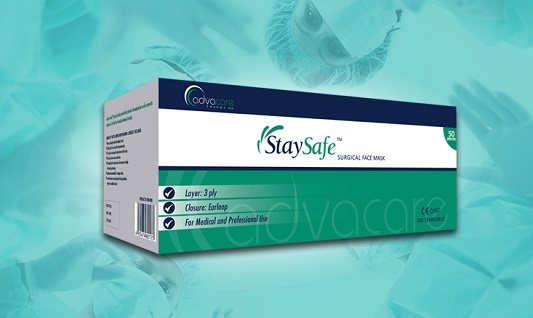Product Details:
Medical Face Mask
provide the mouth and nose a barrier against contaminants and bacteria found in liquid droplets and aerosols, and general fluids from ones environment and surrounding people. These are used by medical professionals both within and outside the surgery, however such masks are also commonly used by the general public especially in heavily populated areas, and people working within dusty environments. It is important to note that medical masks are disposable, and cannot be reused to protect the user against contaminants.
StaySafe™ medical masks can be found in 3 different thicknesses, 2 ply, 3 ply, and 4 ply, which relate to different levels of protection, with 4 ply having the highest level of protection, due to the middle layer which acts as a filter. They also have a bacterial and particle filtration efficiency of 99%, which makes them a highly effective protective device.
There are numerous layers and features of medical masks, each with different applications and uses.
Polypropylene is the most cost-effective material. It is lightweight and water-resistant. It does not offer a high level of protection, so they should only be worn in low-risk environments.
Multi-Layer has a greater level of protection than polypropylene due to its multiple layered structures. It is also non-allergenic and non-stimulating, which translates to increased comfort. Like polypropylene, multi-layer should be reserved for lower-risk environments.
Carbon layered masks are made from activated carbon, and works by removing fumes and chemicals. Because of this ability, carbon masks are suited to higher risk environments where there is a high probability that harmful substances may be inhaled.
A filter paper layer is extremely useful for filtering particles which may be harmful if inhaled, such as microbes. This layer is appropriate for higher risk environments where harmful particulates may be breathed in. There are different grades of filtration: FFP1 = 80% particle filtration, FFF2 = 94% particle filtration and FFP3 = 99% particle filtration.
A valve is a mechanism that is equipped to a medical mask to increase the free flow of air, resulting in easier breathing. The valve also assists in reducing the buildup of heat which can occur when the mask is worn for extended periods of time.
StaySafe™ medical masks are available in 2 types of fastens: earloop, which is simply looped behind the ear, and tie-on, which is tied at the back of the head. As well as this, they come in various sizes, and colors, to suit all needs and preferences. Finally, StaySafe™ face masks are environmentally friendly, and so can be disposed of regularly.
The primary function of medical masks is to prevent the transmission of contaminants such as bacteria between medical professional and patient. The mask acts as a barrier or filter for the mouth and nose.
The medium in which these contaminations reside include droplets shed from the mouth and aerosols.
The mask is designed to catch droplets emitted from the surgeons’ mouth and nose when operating on a patient. They are not designed to protect the wearer of the mask from inhaling pathogens or contaminations that are airborne.
While not its chief intended purpose, the mask also acts as a physical barrier, protecting the wearer from substances which may be present in a surgical environment. Examples include bodily fluids such as blood and chemical agents used during the surgical procedure.
While the intended consumers for medical masks are medical professionals such as doctors and nurses, masks are commonly used by the general public for limiting the amount of pollution particulates inhaled in the air, mainly in densely populated areas where pollution is concentrated.
Medical masks are designed to be disposed after use – this is to prevent the spread of infection or illnesses that may be transmitted by re-using surgical masks. After use, promptly and safely discarding the surgical mask is the necessary course of action.
Interested in more Products?
For more related products, you can also check :
Find more on our website:




